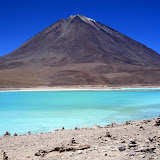Until you consider that miners have a life expectancy of 40 years. We met a father and son team working in the mines. The father was 38 and his two sons were 18 and 15 with three other children at home; the youngest one being 1.5 yrs old. The youngest child will not remember his father who will pass away in 2 years. It’s poignantly heartbreaking. Even more so may be the fate of the two young boys who work with their father. Because they started working in the mines at such a young age, their life expectancy goes down exponentially and reaching the age of 34 may be a lucky scenario. We met children as young as 11 working in various roles in the mines.
The mines are filled with uneducated Bolivians lured in by the comparatively lucrative money to be made. Miners work reasonable hours as they have to be out of the mines by 5pm to allow for the large explosions to open up new passages. They have a large breakfast and dinner and do not eat lunch, instead macerating coca leaves which are purported to provide an energy rush similar to caffeine and to stave off hunger. In order to avoid putting their asbestos covered hands in their mouths while eating the coca leaves, they urinate on their hands prior to eating their lunch. As the mines are cooperatives, the miners get paid in accordance with as much ore as they can pull out of the ground and sell to refineries. Teams within the mines are in constant battle for prime real estate and physical altercations often break out. Miners go on years and years of experience in finding a vein of ore, and there are no regulations as to where you can blast. As a result, miners may accidently blast underneath other preexisting mines, causing cave-ins and casualties.
Miners have health insurance and a decent retirement plan. However, this plan comes with a number of stipulations. In order to get health insurance, the miner must work as a “helper” in a group for 4 consecutive years. After working as a helper for 4 consecutive years with the same team, he gets the insurance and is promoted to a “miner” with access to the more desirable jobs and potential managerial positions. What often happens is young miners do not feel the effects of the dust and asbestos filled air on their lungs, and because they are compensated based on how much ore they extract, they will often switch teams once their particular vein of ore has dried up. The impact is that their 4 year timeline to get insurance starts over. After doing this a couple times, a miner may not get insurance until they are 30 or ¾ of their life is over.
The retirement plan goes as such. If a miner is found to have 50% of their lungs damaged by working in the mines, the miner can retire and get paid the same amount of money (1200 Bolivianos) until they die. The stipulations are that they can only get tested every 4 years. So if a miner is 38 and gets tested and is found to have 45% lung damage he must continue to work until he can get tested again at 42. The problem is that they are often dead before the next scheduled test. Even if they manage to have 50% lung damage and retire and collect on the retirement plan, they are not expected to live more than 1 year past that point.
Traveling has definitely opened my eyes and adjusted my perspective. Things are not always as bad as they seem. Even though the US economy is in shambles, even though gloom and doom abound on every newspaper and news channel on TV, even though I don’t have a job, even though .......
My father is alive and lives past 40. I have a loving family. I have my health. I can afford to travel. I’ll get a new job, it may not be my dream job but I know I won’t starve. Count your blessings. Others are not so fortunate.
Everything is amazing and nobody is happy
 |
| Potosi, Bolivia - Day 1 |
















